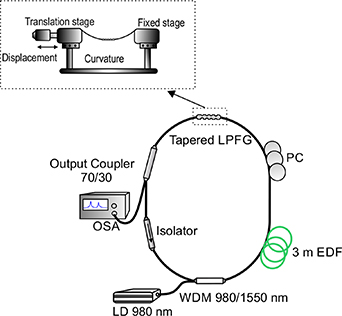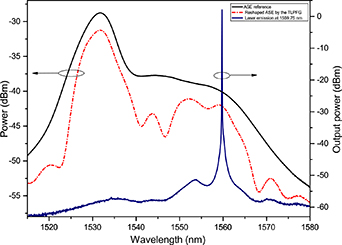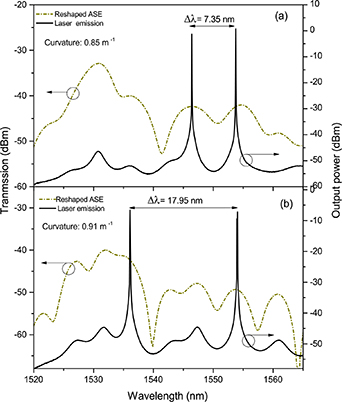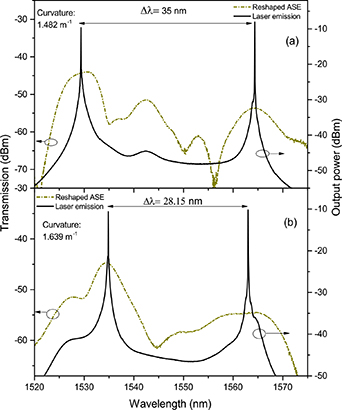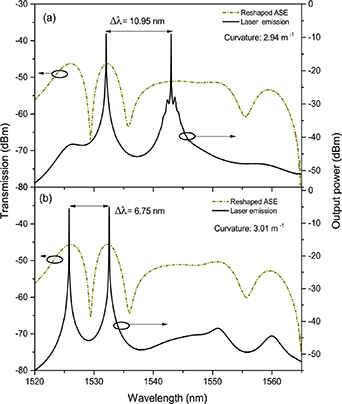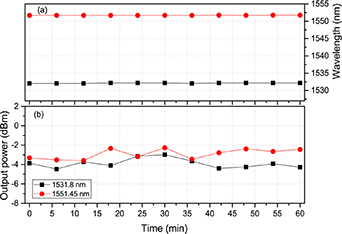Abstract
In this paper, a switchable, dual-wavelength erbium-doped fiber laser, based on the broadband filtering performance of a tapered long-period fiber grating, is experimentally demonstrated. The lasing emission can be built up in sets of dual-wavelengths in the entire C-band, with variable and controllable separation between laser lines from 6.75 nm to 35 nm when the optical fiber filter structure is gradually bent.
Export citation and abstract BibTeX RIS
1. Introduction
Recently, long-period fiber gratings (LPFGs), fabricated by periodically tapering single mode fibers, i.e., tapered-LPFGs (TLPFGs), have demonstrated their excellent performance as all-fiber optical sensors, owing to the fact that their attenuation bands or resonant wavelengths are highly sensitive to temperature, curvature, and the refractive index of the external medium [1–10]. In addition, the fabrication flexibility and repeatability of TLPFGs are now guaranteed by currently available fusion splicers and fiber processing machines, such as the CO2 laser-based glass processor or arc-electric Vytran machines, resulting in high quality and a high degree of sensitivity as compared with conventional LPFGs. One inherent main advantage of the TLPFG is that, being composed of a series of concatenated tapered fibers, the light modes coupled to the cladding are directly exposed to the surrounding external medium, making the TLPFG more sensitive to any changes in the external refractive index, or to strain and curvature, with the advantage of allowing the inclusion of additional mechanisms for spectral modulation if this is necessary for the development of effective fiber sensors.
On the other hand, spectral manipulation of erbium-doped fiber lasers (EDFL) is an important issue, and current efforts aim to obtain versatile performance in areas such as tunability, switching, or multiline emission, using simple low-cost all-fiber filters with easy handling. Some reported works involve the use of fiber tapers, fiber Bragg gratings (FBGs) in conjunction with tapers, multimode interference (MMI) filters, or complex experimental arrangements, such as all-fiber filters, to demonstrate dual-wavelength EDFLs [11–25].
For instance, a pair of FBGs have been employed to form a Fabry–Perot interferometer to generate tunable and switchable dual-wavelength laser emission at around 1569 nm, with a high optical signal-to-noise ratio (OSNR) of 50 dB [13]. Nonlinear Brillouin tunable dual-wavelength EDFLs have been designed which utilize an FBG to adjust the separation between laser lines via a PC [16]. Other experimental results have focused on the generation of dual-wavelength for Yb and Tm-doped fiber lasers, utilizing a nonlinear amplifying fiber loop mirror and two FBGs controlled by a PC [20], high birefringence FBGs (HB-FBGs) under curvature functioning as a tunable dual-wavelength selective element [24], and tunable dual-wavelength EDFs applying mechanical curvature to an MMFI [25]. Another type of fiber filter commonly used in the generation of multi-wavelength laser emission is based on a series of tapered fibers. These structures have proven to be very versatile in terms of tuning the dual-wavelength of EDFLs by controlling the PC of the cavity [11, 12], or bending the tapered fiber manufactured on the active EDF to tune the dual-wavelength in a region between 1528 nm and 1534 nm [21]. Moreover, single to dual-wavelength has been demonstrated, by means of a pair of tapered fibers and a VOA. In this case, by changing the temperature independently on each filter, the emission becomes tunable [22].
More complex cavities to generate dual-wavelength EDFLs have also been reported, where, for instance, the fiber's filter structure comprises a section of single-mode-no-core-hollow-core-no-core-single-mode fiber in line with an FBG [15]. Further complex filters include the Mach–Zehnder interferometer (MZI), formed from two 3 dB couplers and a phase shifted FBG, integrated with a Sagnac loop to generate single and dual-wavelengths [18], and a filter composed of a twin-core photonic crystal fiber (TCPCF) [19].
In this paper, a switchable, dual-wavelength fiber laser is demonstrated. The attenuation bands of the TLPFG filter are reshaped by bending, achieving fixed dual-wavelength lasing. To the best of our knowledge, this is the first time that a TLPFG has been employed as an all-fiber filter to achieve wavelength switchable dual-wavelength emission in a fiber laser.
2. Fabrication and spectral characteristics of the tapered LPFG
The TLPFG used in this work was manufactured based on the parameters laid down in [10]. The filter is composed of six quasi-adiabatic geometrically equal cascaded tapers in a segment of SMF-28. The fabrication process was executed employing a glass processing system, Vytran GP-3400, with the nominally longitudinal dimensions of the tapers set to 1 mm × 1 mm × 1 mm in transition-waist-transition. The average selected period between tapers is 3708 µm, with a 55 µm waist diameter. Figure 1 shows a section of the tapered fiber device, with representative structural dimensions. Basically, a single tapered fiber is a modal interferometer device that couples the light of the core mode to high order cladding modes. This coupling occurs in the slope or transition of the taper. In the waist zone, the cladding-mode and the core-mode acquire a phase difference, due to the exposition of the cladding-mode to the surrounding media. Finally, the cladding-mode is recoupled to the core mode at the second transition, where its spectral characteristics depend directly on its geometrical dimensions. Thus, in this particular case, and due to adiabaticity criteria, for a single taper, only a slight spectral modulation is observed. The transmission spectrum of the cascaded tapers is therefore the result of the accumulated effect and interaction between tapers, resembling the spectral characteristics of an LPFG [10].
Figure 1. Representative image of a section of the manufactured tapered long-period fiber grating filter.
Download figure:
Standard image High-resolution imageThe configuration of the proposed ring laser setup is depicted in figure 2. It is composed of 3 m of large-area erbium-doped fiber (LIEKKI Er16-8/125), pumped with a 975 nm pigtailed laser diode through a 980/1550 nm wavelength division multiplexer. The tapered filter structure is fusion spliced at the end of the doped fiber, and a polarization controller is added at its end. An output coupler is inserted into the cavity to extract 30% of the laser signal, which is monitored using an optical spectrum analyzer (OSA Anritsu 9470A) with a maximum resolution of 0.03 nm; the remaining 70% of the signal is back-coupled to feed back to the ring cavity. Finally, an isolator is included to close the cavity and ensure unidirectional oscillation.
Figure 2. Experimental setup for the dual-wavelength EDFL.
Download figure:
Standard image High-resolution imageTo achieve dual-wavelength switchable laser operation, the TLPFG is gradually bent, placing the filter between two separated mounts (one fixed and the other able to be displace longitudinally), as shown in the inset of figure 2.
Prior to the insertion of the TLPFG into the laser cavity, the filter is first spectrally characterized using an amplified spontaneous emission (ASE) light source, provided by the erbium-doped fiber. In this case, the TLPFG was maintained in a straight position (at zero curvature level). Figure 3 shows the response of the TLPGF's transmission spectrum (red dashed dotted line) with respect to the input ASE optical source as reference (black straight line). In this figure, four main attenuation bands can be observed, three of them well defined and centered at resonant wavelengths of 1541.25 nm, 1546.65 nm, and 1568.3 nm. Nevertheless, the formation of a fourth attenuation band can be observed to a limited extent, appearing as a notched band, centered at 1556.5 nm. For a tapered section of a standard step-index single-mode fiber (SMF), the waist diameter is the main factor determining the spectral position, while the separation between tapers the bandwidth of the attenuation bands [10]. In [26], the experimental results showed that by selecting a waist diameter of 55 µm, broadband attenuation bands are formed in the 1500–1600 nm range. The four attenuation bands result from the cumulative effect of each concatenated taper. On the other hand, the total insertion loss of the filter was measured at about 2.48 dB.
Figure 3. ASE reference, ASE reshaped by the TPLFG, and free-running lasing.
Download figure:
Standard image High-resolution imageOnce the ring cavity is connectorized, it is continuously pumped with 60.8 mW of launched pump power. At this initial condition, the lasing wavelength builds to 1559.7 nm, with an SMSR level of 53.5 dB and ∼30 pm spectral width (in a 3 dB bandwidth), in accordance with the resolution of the OSA depicted in figure 2 (blue straight line). As is widely known, the shape of the gain of an erbium-doped fiber is a complex function of pump power, wavelength, and fiber length, due to the three-level nature of the erbium ion. As the doped fiber length is increased, the lasing wavelength shifts towards longer wavelengths. In our case, the 3 m of Er-doped fiber (LIEKKI Er16-8/125) permits a laser oscillation close to 1565 nm in a free-running configuration (in the absence of a filter). Subsequently, the intracavity addition of the TLPFG situates the lasing wavelength at 1559.7 nm, due to the reshaping of the laser gain.
3. Switchable dual-wavelength laser operation
The lasing emission can switch between sets of dual wavelengths by controlled bending of the TLPFG. At zero curvature (where curvature is defined as the inverse radius of curvature, C = 1/R, and where R is measured in meters), the laser is built up in a single wavelength (figure 3). In addition, in order to investigate how the broadband reshapes the attenuation bands, evolves, and facilitates switchable multi-wavelength laser oscillation, the ASE spectrum and laser signals were measured and overlapped into the same figures (for the corresponding curvature levels). By increasing the curvature of the TLPFG from 0 m−1 to 0.85 m−1, dual-wavelength is established at wavelengths of 1546.4 nm and 1553.75 nm, as depicted in figure 4(a). We note how the redistribution of the ASE spectrum (green dashed-dotted line) brings about two main notched bands (centered at 1541.35 nm and 1550.9 nm), and the lasing wavelength settles, matching the maximum peaks of the reshaped ASE. On increasing the curvature to 0.91 m−1, the dual-wavelength switches to wavelengths of 1536.1 nm and 1554.04 nm, as shown in figure 4(b). Regarding figure 4(a), the new reshaped ASE acquires a comb-like filter spectrum, where its attenuation bands increase in depth and shift slightly towards shorter wavelengths, redistributing the gain profile and promoting lasing at these wavelengths. This effect facilitates dual-wavelength switching, with a separation between laser lines of 17.95 nm.
Figure 4. Switchable, dual-wavelength lasing at different curvatures, overlapped with the respective modified ASE, for (a) 0.85 m−1, and (b) 0.91 m−1.
Download figure:
Standard image High-resolution imageFor an applied curvature of 1.482 m−1, dual-wavelength (1529.35–1564.35 nm) is generated, with a separation of 35 nm between lasing lines, as shown in figure 5(a). We note that three attenuation bands are centered within the interval from 1535 nm to 1560 nm, introducing high losses, and causing the gain to be distributed to the two furthest points, where the dual lasing is located. Furthermore, dual-wavelength operation was switched at wavelengths of 1534.85 nm and 1563 nm for a curvature of 1.639 m−1, as shown in figure 5(b). At this point, there was a single attenuation band, centered at 1544.7 nm, with a broader loss bandwidth. This suppresses the middle wavelengths of the ASE emission, between 1537 nm and 1560 nm, and shifts the maximum gain peaks towards the center of the spectrum.
Figure 5. Switchable, dual-wavelength lasing at different curvatures, overlapped with the respective modified ASE, for (a) 1.482 m−1, and (b) 1.639 m−1.
Download figure:
Standard image High-resolution imageMoreover, for curvatures of 2.948 m−1 and 3.014 m−1, the dual laser oscillation is set to wavelengths of 1532.05–1543 nm and 1525.8–1532.55 nm, respectively, as shown in figures 6(a) and (b). In both figures, the reshaped ASE exhibits three attenuation bands, located at wavelengths of 1529.4 nm, 1535.65 nm, and 1555.55 nm. As shown in figure 6(a), a flattened zone in the ASE spectrum is generated between the two longest wavelength resonant bands, which induces the oscillation of side modes near the lasing wavelength, caused by strong mode competition (straight black line). On the other hand, in figure 6(b), this flattened zone is slightly redistributed, with a slow inclination to the longer side of the optical spectrum, unbalancing the gain and switching the laser to the shortest lasing wavelength, where a gain peak at ∼1526.25 nm is observed (with a spacing of 6.75 nm between the laser lines). In addition, figure 7(a) reveals the formation of a fourth attenuation band, centered at ∼1547.3 nm, while its adjacent attenuation band (∼1536.5 nm) decreases in depth, resulting in two dominant gain peaks where the ASE spectrum matches the built up laser oscillation at 1531.8–1551.45 nm (the separation between lines is about 19.65 nm, at a curvature level of 3.1 m−1). Finally, for the maximum applied curvature of 3.47 m−1, dual-wavelengths are generated at wavelengths from 1524.8–1550.05 nm, as illustrated in figure 7(b). The increment in the curvature of the TLPFG increases the optical losses into the laser cavity; this effect varies the OSNR of the lasing wavelengths from −53 dBm to −42.67 dBm.
Figure 6. Switchable, dual-wavelength lasing at different curvatures, overlapped with the respective modified ASE for (a) 2.94 m−1, and (b) 3.01 m−1.
Download figure:
Standard image High-resolution imageFigure 7. Switchable, dual-wavelength lasing at different curvature, overlapped with the respective modified ASE, for (a) 3.1 m−1, and (b) 3.47 m−1.
Download figure:
Standard image High-resolution imageTo evaluate output power and wavelength stability, the dual-wavelength achieved at a curvature of 3.1 m−1 was analyzed at room temperature. The measurement was carried out by scanning the output spectra of the laser wavelengths ten times over an interval of 1 h. Figure 8 depicts the spectral distribution of the dual-wavelength, measured at intervals of 6 min between samples, while figure 9(a) illustrates the wavelength shifting, and the characterization of power fluctuation in figure 9(b). The maximum wavelength fluctuation for both lasing wavelengths is about 0.06 nm. On the other hand, deviation in the power fluctuation at a wavelength of 1531.8 nm is ±0.48 dB, whereas it measures ±0.51 dB for a lasing wavelength of 1551.45 nm at room temperature. These results indicate that the proposed switchable dual-wavelength laser is highly stable in terms of wavelength and output power fluctuations. Nevertheless, there are undesirable instabilities which may shift the lasing wavelengths, generated by variations in the surrounding environment, such as changes in temperature or small vibrations, since some of the coupled energy of the cladding-modes traveling along the TLPFG interacts with the exterior media. Moreover, fluctuations in the pump power can contribute to the increment of these instabilities.
Figure 8. Dual-wavelength lasing, measured at intervals of 6 min between samples.
Download figure:
Standard image High-resolution imageFigure 9. Measurement of laser stability over 1 h, for (a) wavelength deviation, and (b) output power.
Download figure:
Standard image High-resolution image4. Discussion
The curvature applied to the TLPFG induces stress; we therefore experimentally adjust the effective refractive index of the core and coupled cladding-modes via the photoelastic effect. These variations modify the transmission spectrum of the TLPFG by coupling higher order cladding-modes, causing its attenuation bands to exhibit effects such as displacement of the resonant wavelength, modifications in terms of depth, or the emergence of new attenuation bands in distinct zones of the spectrum. These effects occur in the transmission spectrums of figures 4–7 (green lines) as a function of curvature. A remarkable point to note in these figures is that a correlation between the reshaped ASE spectrum and the laser emission can be observed: the laser emission is built up in the maximum gain peaks of the redistributed ASE spectrum, generating dual-wavelengths with different separation between lasing lines, distributed over the entire C-band of the EDF, which is a very significant result. The main output characteristics are: an OSNR above 43 dB for most of the dual-wavelength lasing, together with a high spectral stability and an output power deviation of 0.06 nm and ±0.51 dB, respectively. The separation between dual-wavelength can be controlled from 6.5 nm to a maximum of 35 nm by increasing the curvature of the TLPFG, in a range from 0 m−1 to 3.47 m−1.
To compare this work with the literature, see table 1. In this table, two important aspects of the revised approach are analyzed: the filters employed, and the lasing performance of the demonstrated fiber lasers. The lasing performance is analyzed in terms of the lasing wavelengths, side-mode suppression ratio, and power fluctuations.
Table 1. Comparative table.
| Employed filter (WD = waist diameter, FP = | Lasing performance (PF = power fluctuations, | |
|---|---|---|
| Fabry–Perot, FBG = fiber Bragg grating, MZFI= | SMSR = side-mode suppression ratio, LW = lasing | |
| Ref. | Mach-Zehnder fiber interferometer) | wavelengths, DW = dual-wavelength) |
| [11] | Non-adiabatic single tapered fiber, WD ∼2 µm. | Tunable DW at 1556 nm-1562.13 range, SMSR ∼50 dB. PF of ∼0.5 dB |
| [12] | A dual tapered MZFI, WD ∼9 µm | DW lasing in the 1036.4 and1044 nm range with tunable spacing, SMSR of 50 dB |
| [13] | A pair of FBG as an FP filter | DW in the 1568–1569 nm range with tunable spacing, SMSR is ∼50 dB. Maximum PF is ∼2 dB |
| [14] | Non-adiabatic single tapered fiber, WD = 7 µm. | DW at 1958 nm and 1980 nm, with SMSR around 67 dB. PF did not exceed 3 dB. |
| [15] | Two FBGs, an SNHNS interferometer | DW at 1550.11 nm and 1553.62 nm, SMSR of 48 dB, PF less than 0.28 dB |
| [16] | A saturable absorber, a compound cavity, and a tapered fiber | DW at 1550 nm and 1554 nm. Peak power drift is less than 0.5 dB, and the signal to noise ratio was higher than 60 dB |
| [17] | FBG in conjunction with PC | DW at 1549.982 nm and 1550.082 nm, SMSR of 60 dB, PF is below of 1.6 dBm |
| [18] | Phase-shifted FBG combined with MZFI and Sagnac loop | Laser wavelength ranges from 1555.58 to 1559.92, and the DW separation as small as 0.04 nm. SMSR more than 40 dB. PF not available. |
| [19] | Twin-core photonic crystal fiber (TCPCF) based filter with MZI in cascade | Tunable DW lasing from 1559.72 nm/1560.48 nm to 1593.54 nm/1594.32 nm. SMSR = 45 dB. Peak PF is less than 0.8 dB |
| [20] | Nonlinear amplifying fiber loop mirror and FBG pair | DW at 1064.65 nm and 1065.45 nm. OSNR is greater than 50 dB, and the PF is under 1.03 dB |
| [21] | Concatenated tapers with WD ∼5 µm | Tunable DW at 1528 and 1534 nm range, SMSR ∼46.88 dB. power fluctuation less than 0.38 dB |
| [22] | Tapered optical fiber structure | DW at 1530.2 nm and 1 550.1 nm, SMSR = 43 dB |
| [23] | Two identical abrupt tapers with WD ∼48 µm, | DW lasing at 1546.23 and 1554.76 nm, OSNR ∼50 dB, |
| [24] | High birefringence FBG | DW at the1941.40 and 1942.21 nm, PF ∼1.2 dB |
| [25] | Single multimode interference filter. | DW in the 1527–1585 nm range with tunable wavelength spacings, SMSR = PF less than 1.2 dB |
| This work | Six quasi-adiabatic geometrically equal cascaded tapers in a segment of SMF-28 as a TLPFG | DW distributed in the entire C-band, with wavelength spacing from 6.75 nm to 35 nm, PF less than 0.51 dB, Maximum SMSR ∼43 dB |
In contrast with some reported experimental results, fiber lasers comprising intra-cavity LPFGs exhibit great finesse and stability in their lasing wavelengths, however, their wavelength separation range is small, being only a few nanometers, as reported in [13, 20, 24]. Another advantage of the proposed TLPFG structure is its compact dimensions, given that the structure measures only about 2.54 cm in length. In this context, the filter can be manipulated over a wider safe range, thereby avoiding fiber breakage, as compared with other works [11, 14, 21] where the tapered MZFI filter has a waist diameter equal to or less than 7 µm. On the other hand, due to the exposure of the fiber core of the TLPFG to the external environment, the filter's sensitivity can be employed as a refractive index sensor in order to generate a multi-parameter fiber laser sensor, in combination with curvature or temperature, or even allowing for different features, such as tunability. Finally, another point to remark is the relative low-cost, time and ease of manufacturing of the TLPFG, since it is fabricated on a standard SMF-28 in contrast with more complex structures such as the TCPCF in [19], while displaying similar lasing output characteristics.
5. Conclusion
By reshaping the attenuation bands of a TLPFG by bending, a switchable, dual-wavelength laser operation of an erbium-doped fiber laser has been demonstrated. The lasing wavelengths and the output power demonstrates effective stability, with measured values of about 0.6 nm and ±0.51 dB, respectively, distributed across the entire C-band wavelength range. In general terms, the advantages of the TLPFG include its relatively low-cost fabrication, via micro machining on a standard SMF-28, and a compact size of less than 2.54 cm total length. To the best of our knowledge, this is the first time that a TLPFG has been employed as an all-fiber filter to achieve switchable dual-wavelength emission.




